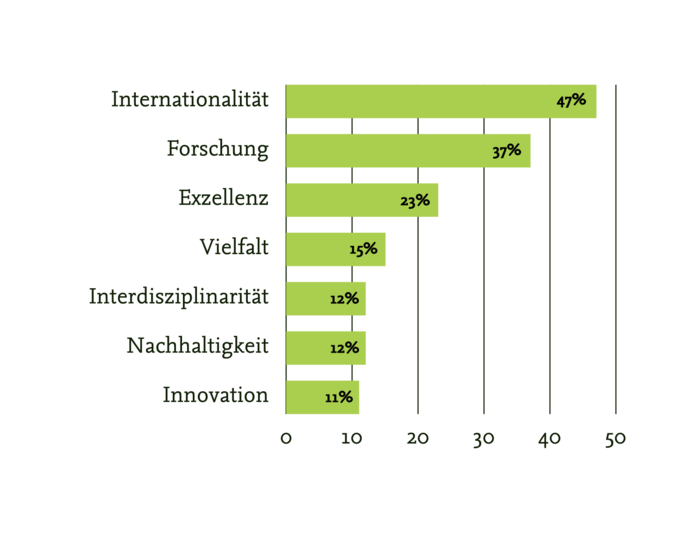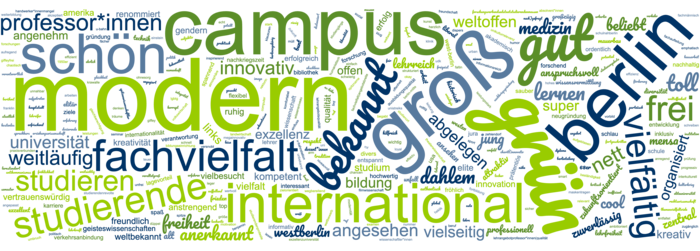Insights – Analyses, Interviews, and Surveys
Figure 1: Use of attributes in the mission statements of German universities (%)
Image Credit: Freie Universität
Below you will find a selection of key findings and observations from our research related to the brand development process.
Competitor Analyses (March 2022)
Two competitor analyses (on the national and international level) were conducted in early 2022. We screened more than one hundred universities in order to select and analyze the most important keywords they used in how they represented themselves. Seventy-two public universities with at least five thousand students were included in the national competitor analysis. Taking the QS World University Rankings as our basis, we selected thirty-nine top universities in eight European countries and six non-European countries for our international competitor analysis.
“Internationality,” “excellence,” and “sustainability” are among the most frequently mentioned terms in the official content German universities use to promote and represent themselves (Figure 1).
Foreign universities also prominently feature “internationality” and “excellence” in their self-promotion materials (Figure 2).
This means that the attributes of “excellence,” “internationality,” and “sustainability” do not distinguish Freie Universität Berlin clearly from other universities on either a national or international level. If one or more of these terms were included in the new brand identity, significant efforts would have to be made in order for this attribute to sound particularly unique and original.
Interviews (April to July 2022)
Having completed the competitor analyses, we conducted in-depth qualitative interviews lasting approximately one hour with more than twenty internal and external stakeholders between April and July 2022. Respondents were asked about their professional relationship to Freie Universität, their perception of Freie Universität Berlin (image, external presentation, logo, mission statement), their opinions on how Freie Universität should represent itself, possible key topics for future and current challenges, and the most important competing institutions and benchmarks for Freie Universität.
We also asked our interviewees whether they actually associated the keywords used in the university’s public image with Freie Universität. This was confirmed to a high degree for “excellence” and “internationality,” but to a lesser extent for “sustainability” and “diversity.”
We asked the respondents which keywords they connect with Freie Universität. Many interviewees referred to the Freie Universität campus and its size (e.g., “green,” “Dahlem,” “large.”) “Freedom” in both historical and social/scholarly perspectives was also frequently mentioned (Figure 3).
These two conceptual spheres were also repeatedly invoked when we asked how Freie Universität could present itself in the future. Several respondents pointed out that Freie Universität should position itself somewhat more broadly and less leftist. Its insistence on consistently referring to the student movement of the late-sixties, for example, overshadows other (historical) resources that could be used in the rebranding process.
In terms of the question about Freie Universität’s functions and roles on various levels (city of Berlin, national, international), it was also suggested that Freie Universität should position itself more strongly and openly as an arena for societal debate in the future.
Internal stakeholders repeatedly criticized the insufficient or unclear way in which internal communication was addressed, as well as the frequency of communication. However, these assessments are difficult to categorize due to the large number of organizational units and actors communicating internally. Internal stakeholders also criticized Freie Universität’s administrative processes as inflexible and dysfunctional. In contrast, external communication was predominantly assessed as successful.
Master’s thesis with survey of Berlin residents (August to September 2022)
Figure 4: Should Freie Universität emphasize the concept of freedom in its image? (Berlin survey)
Image Credit: Freie Universität
Figure 5: Word cloud for “When you think of Humboldt-Universität, what three terms spring to mind?” (Berlin survey)
Image Credit: Freie Universität Berlin
Figure 6: Word cloud for “When you think of Humboldt-Universität, what three terms spring to mind?” (Berlin survey)
Image Credit: Freie Universität Berlin
A survey of Berlin residents was conducted as part of a master’s thesis at the School of Business and Economics. Five hundred people from Berlin were asked a series of questions about their perception of Freie Universität’s quality, communication, modernity, mission statement, and what it has to offer in general. An affective component was also included. For a comparative perspective, the survey also asked respondents about their perception of Humboldt-Universität zu Berlin.
As part of the master’s thesis, the results were grouped according to their importance for perception and according to the quality of performance on an Importance-Performance Map. This four-field matrix is difficult to interpret for the brand development process of Freie Universität Berlin, since the evaluation was carried out for both universities. Nevertheless, it is interesting to note that Humboldt-Universität and Freie Universität are almost on a par in all factors on average and, with one exception, were consistently rated positively by the respondents. Performance in the mission statement factor was rated as poor for both universities, but also as unimportant. The similarity of the respondents’ assessment of both universities suggests that neither succeeds in clearly presenting their strengths to the general public and in differentiating themselves from one another.
In addition, participants were asked whether Freie Universität should place more emphasis on the concept of freedom in its future self-promotion. 44.4 percent agreed, 47.2 percent did not indicate a preference here. Only 8.4 percent of respondents disagreed (see Figure 4).
When asked what keywords they would spontaneously think of when asked about Freie Universität, around twenty percent of respondents failed to come up with an answer. The remaining respondents perceived Freie Universität as international and closely connected to Berlin. Here, too, the size of Freie Universität is seen as a distinctive feature (see Figure 5).
Twenty-five percent of respondents did not connect any keyword with Humboldt-Universität. The rest associated Humboldt-Universität with Wilhelm and Alexander von Humboldt, as well as with tradition, Berlin, and internationality (see Figure 6).
Residents of Berlin perceived both Humboldt-Universität and Freie Universität as international. This may well be a characteristic that is generally attributed to universities, or at least to large urban universities. The same applies to excellence and high quality standards, which were also attributed to both universities by a majority of respondents. The two universities do not seem to be perceived as very distinct from one another, at least in this sample of Berlin’s population.
Survey of Freie Universität members (September to October 2022)
Figure 7: Word cloud for “When you think of Freie Universität, what three terms spring to mind?” (Freie Universität survey)
Image Credit: Freie Universität
Figure 8: Word cloud for “What do you think is in Freie Universität’s DNA?” (Freie Universität survey)
Image Credit: Freie Universität
A total of 3,088 participants participated in the internal survey. 1,321 of them completed the questionnaire. The invitation to participate was sent to a total of 47,500 email addresses.
In the survey, members of Freie Universität were asked for their assessment of various aspects of Freie Universität’s performance. We also inquired about their connections to Freie Universität. In addition, questions were asked concerning their evaluation of the campus and their opinion of prominent terms in the university’s current public image, as well as their perception of Freie Universität in affective terms.
We again asked about the three keywords connected with Freie Universität (see Figure 7) and its perceived DNA (see Figure 8).
Both the fact that the campus in Dahlem is so large and green and Freie Universität’s remote location play an important role. The concept of “freedom” is also frequently mentioned. Another common association with Freie Universität for our internal respondents is Freie Universität’s bureaucracy.
When asked about Freie Universität’s DNA, research and teaching as well as its internationality were highlighted. This again indicates that Freie Universität’s considerable investment in its image in recent years has been successful. A new addition are “diversity” and “freedom” as important ingredients of Freie Universität’s DNA. However, there were also many respondents who either had nothing to say or refused to answer. Quite a few respondents noted that the question was either superfluous or irrelevant because an institution by its very definition does not have DNA. A comparable future questionnaire might instead ask about Freie Universität’s core character traits.
From the in-house perspective, Freie Universität is most clearly identified with “internationality.” This is followed by “diversity” and “freedom.” However, Freie Universität is also associated with “liberalism” and “networking” (see Figure 9). Its internal presentation as an international network university has thus been successful.







